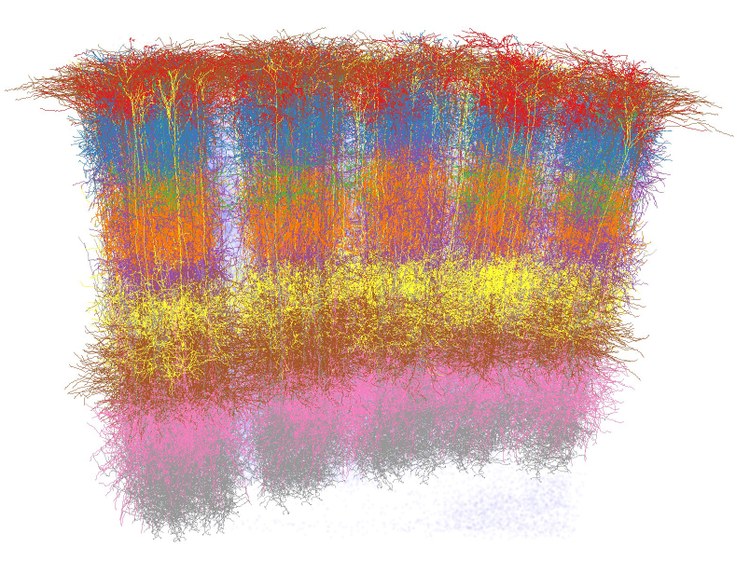Neuroscientists find cortical columns in brain not uniform, challenging large-scale simulation models
October 25, 2013
[+]
Despite a long-held scientific belief that cortex is built up by repeatedly occurring elementary units called cortical columns, a new study by neuroscientists has found
that the structure of the brain’s cortical columns can largely deviate
within individual animals, and even within a specific cortical area.
Cell-type-specific
3D reconstruction of five neighboring barrel columns in rat vibrissal
cortex (credit: Marcel Oberlaender et al.)
The study also found that these structural differences are not arbitrary, but reflect organizational and functional properties of the peripheral sensory organs.
The study was based on recent advances in high-resolution imaging and reconstruction techniques (confocal microscopy and automated image-processing routines) developed by Dr. Oberlaender at the Max Planck Florida Institute for Neuroscience, enabling researchers to automatically and reliably detect the 3D location and type of every nerve cell throughout the entire brain.
Published in the Proceedings of the National Academy of Science (open access), and conducted by researchers at the Max Planck Florida Institute for Neuroscience (MPFI), the Max Planck Institute for Biological Cybernetics (MPIBC) in Tuebingen, Germany, these findings promise to open new avenues of research on brain organization and sensory information processing.
Questioning cortical uniformity
[+]
“This study resolves a decade-old controversy whether the structure
of the cerebral cortex is uniform across cortical areas and species,“
said MPFI/MPIBC neuroscientist Marcel Oberlaender, PhD, corresponding
author of the paper.
Rodents,
like mice and rats, use facial whiskers as active sensory organs to
navigate through their environment. The information from each whisker is
represented in the rodent brain by elementary units called cortical
columns. (Credit: Max Planck Florida Institute for Neuroscience)
“By determining the exact numbers and distributions of nerve cells within almost 100 cortical columns, the substantial differences observed across columns within the same animal argue against the principle of cortical uniformity.”
The researchers conducted their study by examining the brains of rats, focusing on the entire area of the brain known as the vibrissal cortex, which processes information obtained from facial whiskers located along the animals’ snout. Each cortical barrel column in the vibrissal cortex corresponds to one whisker.
It has been thought that the number of nerve cells within each column is the same, but this was not found to be the case in the rodents studied.
500,000 neurons related to whiskers
Being nocturnal animals, rats mainly rely on their whiskers as active sensory organs to explore and navigate their environment. For this reason, the whisker system is an ideal model for studying whether the brain circuits involved in processing information from different sensory organs are structured uniformly or not.
By simply detecting and counting every nerve cell in the entire vibrissal cortex, the scientists sought to elucidate the general principles that underlie the cellular organization of the mammalian cortex.
On examination, they found that rat vibrissal cortex comprises about 500,000 neurons, the number and 3D distribution being remarkably preserved across animals. More importantly, the number of neurons per cortical column varied between 10,000 and 30,000 within individual animals.
Cortex structure shaped by sensory information
Their findings were particularly striking because the differences in column organization were not random, but based on function: the number of nerve cells per cortical column reflected the distance of the respective whisker from the ground.
“We’ve shown that the structure of the mammalian cortex is not determined by some uniformity rule, and that cortices are not built up of elementary columnar networks that can be extrapolated across cortical areas or even species,” said Dr. Oberlaender.
“Instead, the organization of the cerebral cortex seems to be shaped by the information obtained at the peripheral sensory sheet, a finding that may pertain to other sensory systems and species, including people.
“Our findings open the possibilities of new avenues of research on the relationship between brain structure and function — for example, by using quantitative anatomical studies combined with noninvasive imaging technologies suitable for humans, such as functional MRI (fMRI).”
The researchers also state in the PNAS paper that their findings “challenge the concepts underlying contemporary simulation efforts that build up large-scale network models of repeatedly occurring identical cortical circuits.”
Oberlaender explained to KurzweilAI that while there may not be an immediate practical use, “our findings will influence many fields of neuroscience research, from behavior to imaging, such as fMRI.”
Abstract of PNAS paper
The cellular organization of the cortex is of fundamental importance for elucidating the structural principles that underlie its functions. It has been suggested that reconstructing the structure and synaptic wiring of the elementary functional building block of mammalian cortices, the cortical column, might suffice to reverse engineer and simulate the functions of entire cortices. In the vibrissal area of rodent somatosensory cortex, whisker-related “barrel” columns have been referred to as potential cytoarchitectonic equivalents of functional cortical columns. Here, we investigated the structural stereotypy of cortical barrel columns by measuring the 3D neuronal composition of the entire vibrissal area in rat somatosensory cortex and thalamus. We found that the number of neurons per cortical barrel column and thalamic “barreloid” varied substantially within individual animals, increasing by ∼2.5-fold from dorsal to ventral whiskers. As a result, the ratio between whisker-specific thalamic and cortical neurons was remarkably constant. Thus, we hypothesize that the cellular architecture of sensory cortices reflects the degree of similarity in sensory input and not columnar and/or cortical uniformity principles.
(¯`*• Global Source and/or more resources at http://goo.gl/zvSV7 │ www.Future-Observatory.blogspot.com and on LinkeIn Group's "Becoming Aware of the Futures" at http://goo.gl/8qKBbK │ @SciCzar │ Point of Contact: www.linkedin.com/in/AndresAgostini
 Washington
Washington